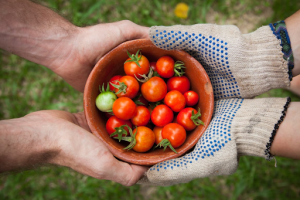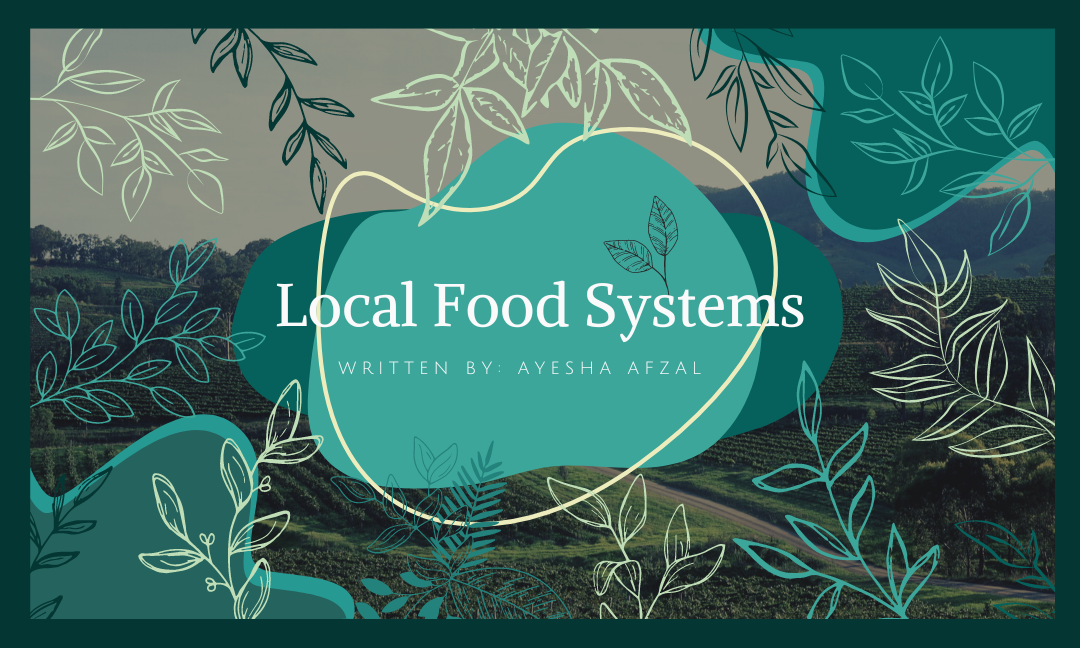Written By: Ayesha
Edited By: Morgan Pankarican
Design By: Ayesha
Published By: Maryam Khan
Introduction:

The word food systems can mean a lot of different things. But, when we are specifically looking at “local” food systems, that is food produced locally in an area. For example, food systems in Ontario are different from food systems in another province in Canada or another country in the world. Every individual can do their part to support the production of food as well as the preservation of the natural environment. Yet, the question remains: what are local food systems? Well, they are a network of sustainable food producers which strive for sustainable food production. Fresh produce from farms is sold directly to the consumers in that area through community-oriented events such as farmers markets, local grocery stores and pick-your-own produce farms.
 Why are local food systems important?
Why are local food systems important?
They are healthier: Food that reaches a kitchen the quickest after being harvested is the healthiest produce. Though fruits and vegetables are healthy by themselves, the nutrients and vitamins can drain over time. Food is the freshest and richest in nutrients when it is just harvested and ripe. Usually, the produce we buy at a farmer’s market is picked or harvested within twenty or twenty four hours before. This means that the produce sold at farmers markets is better and more nutritious than produce sold in bulk, imported from elsewhere. When farmers sell food locally, they do not have to worry about making their produce last a longer period of time in order for it to be shipped, or distributed in other distant places, treating them with chemicals . Instead, local farmers can focus on the quality and flavor of their produce rather than the durability!
There is no transportation needed: “The food system that most of us encounter on a daily basis is sprawling — many of the fruits, vegetables, and grains we put into our grocery baskets are grown and processed thousands of miles away.” (Joe McCarthy). Transportation of our food from faraway places affects our environment. When we buy produce and food items from local producers, transportation is not required. This makes the product much better for our health and environmentally friendly.

They are better for the economy: When we buy food from local farms and markets, it develops a better economic standing between food producers and food consumers. It is essential that we support local farmers as they too need the investment we provide by purchasing their crops to be able to continue the local food system they have created. Plus, we get much healthier food in return! As it supports the local economy, purchasing locally grown food also promotes safe food supply, as there are less steps between the food and the consumer making it less prone to contamination.
How can you support local food systems?
It isn’t just about buying produce from local farmers, there is a lot more to do to ensure that we are doing our best to preserve local food systems.
 1) Awareness: Joining local garden communities and spreading awareness about the importance of local food systems is the first essential step.
1) Awareness: Joining local garden communities and spreading awareness about the importance of local food systems is the first essential step.
2) Start a small garden: Get outside in your backyard or any outdoor space and start a small garden by growing easy crops such as tomatoes or peppers. By doing this, we can observe how the food we eat everyday grows and understand the importance of preserving food systems for the future.
3) Regenerative agriculture: Supporting regenerative agriculture is essential as it practices crop rotation and lets the soil rebuild in between seasons to enable sustainable irrigation practices. We can support by donating to organizations that help farmers shift into regenerative farming as it is never an easy task! We can also buy our food and produce directly from regenerative farms in your area.
References:
Agricultural Law Information Partnership. (n.d.). Local Foods and communities. Local Foods and Communities | National Agricultural Library. Retrieved March 14, 2023, from https://www.nal.usda.gov/human-nutrition-and-food-safety/local-foods-and-communities#:~:text=Local%20foods%20are%20marketed%20through,%2C%20schools%2C%20and%20other%20outlets.
Hendrickson , M., Massengale , S. H., & Weber , C. (n.d.). Introduction to local food systems. University of Missouri Extension. Retrieved March 14, 2023, from https://extension.missouri.edu/publications/dm271#:~:text=A%20local%20food%20system%20expands,centered%20on%20a%20particular%20place.
Julia Darnton, R. K. (2022, January 21). Seven benefits of local food. Community Food Systems. Retrieved March 14, 2023, from https://www.canr.msu.edu/news/seven-benefits-of-local-food
Local Sustainable Food Systems Network –. Food Secure Canada. (n.d.). Retrieved March 14, 2023, from https://foodsecurecanada.org/community-networks/local-sustainable-food-systems/network-resources
McCarthy, J. (2021, July 26). 6 ways you can support local food systems. Global Citizen. Retrieved March 14, 2023, from https://www.globalcitizen.org/en/content/how-to-support-local-food-systems/#:~:text=If%20you%20have%20a%20backyard,with%20some%20delicious%2C%20fresh%20vegetables.
Image Citations:
Kamala Bright on Unsplash
Somi Jaiswal on Unsplash
Red Zeppelin on Unsplash
Elaine Casap on Unsplash

